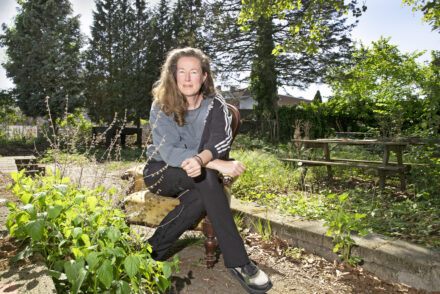Saint Nicholas’ controversial helper
The ‘Black Pete-debate’ rages again in the Netherlands. Opponents see him as an offensive caricature, while the majority of Dutch people see him as harmless and as an important part of Dutch culture. Which side is right? Univers editor Leanne Soff looks into the history of Black Pete and tries to find a solution.
Sinterklaas is coming to town, and so are his helpers. Every year they bring gifts, joy and sweets, but also something less festive: a discussion about racism and cultural adaptation.
Sinterklaas is actually not so different from the Americanified Santa Clause. He too delivers presents to children by climbing through chimneys, except that our Sinterklaas rides the roof on a white horse and comes a little earlier: Sinterklaas is traditionally celebrated on the evening of the fifth of December. Sinterklaas’ age is not something to be spoken of, but there is one general agreement: Sinterklaas is very, very old. One could hardly expect him to single-handedly deliver presents to every person in the entire country. Thankfully, Sinterklaas has a bunch of helpers. His young and healthy helps have no problem climbing up rooftops and going through chimneys to bring gifts and joy to everyone. They are cheerful and energetic with colorful clothing. Their gimmicky characters bring joy to many children. Yet there is one aspect of these helpers that causes a national discussion year after year: their black skin.
This is not a discussion about children, it is a discussion about grownups and recognition
Though I can understand the debate now, I have to admit that, as a child, I never noticed anything weird about it. Let’s face it, there were stranger things going on than the black faces. For example, the fact that we didn’t have a chimney, but somehow the gifts still found their way into our home. Or the fact that when Sinterklaas came to visit my school, my mum was the one who drove him there. In our own car. And he happened to be wearing my dad’s shoes. I did not bat an eye. As long as I got presents and some sweets, I was willing to accept most anything. But then again, this is not a discussion about children, it is a discussion about grownups and recognition, and it has been going on for years now.
Slavery
Many opponents of this helper that we call ‘Zwarte Piet’ (Black Pete) argue that the skin tone of Zwarte Piet implies a background of slavery and encourages discrimination and racism. Though many people nowadays don’t link Zwarte Piet directly to slavery, it is not so strange to think that the roots of this figure might be closely connected to slavery.
Zwarte Piet as we know him today was first introduced in 1850, when a book called “Saint Nicholas and his servant” by Jan Schenkman was published. This is thirteen years before the overall abolishment of slavery in Dutch colonies. It is thus not unthinkable that Zwarte Piet was originally inspired by Afro-American slaves from colonial times. Though some argue that later in time, his dark skin was explained by soot from the chimneys Zwarte Piet climbs through, opponents still feel that there are too many connections to slavery.
Protest
In the 1960s, protests slowly started to arise. Some magazines wrote critical articles about Zwarte Piet and some associations started raising their voices, but things remained fairly civil and small-scaled. As time develops, so does the debate and by the 1980s, it has already become more of a national issue. Some schools even decided to no longer portray Zwarte Piet. However, in 2006 things become serious.
Protests already started to arise in 1960, and by the 1980s Zwarte Piet had become a more national issue
Since 2001, a daily ‘news’ show about the whereabouts of Sinterklaas and his Zwarte Pieten, called the ‘Sinterklaasjournaal’, had developed into a national treasure. Every year, a story line surrounding Sinterklaas and the Zwarte Pieten would be created and told from a couple of days before the arrival of Sinterklaas to the day of celebration, December 5th. As a central point of influence in this debate, the Sinterklaasjournaal attempted in 2006 to find a solution to the discussion about Zwarte Piet. In 2006’s story line, Sinterklaas’ steamboat accidentally sailed through a rainbow, turning the Zwarte Pieten into all sorts of colors, calling them Rainbow Pieten. A fun and creative solution it seems. Many Zwarte Piet fanatics, however, disagreed. The show started receiving angry letters, the presenter received death threats: it seemed that the pro-Zwarte Piet movement was equally, if not more passionate and aggressive about their cause than its opponents.
From then on, measures started becoming more drastic and more aggressive. In 2011, a group of anti-Zwarte Piet activists protested at the arrival by steamboat of Sinterklaas in Dordrecht, in the midst of hundreds of joyful children. Though the protest was intended peacefully, the activists were arrested with considerable violence. An extra element was now added to the debate. Next to the already existing two groups, pro- and anti-Zwarte Piet, a third group arose: a group of people who were not too bothered either way, but felt that this was not a fight to be fought in the presence of children.
Court
Considering the controversy around their protest, seven anti-Zwarte Piet activists chose a different path to achieve their goals. In 2014, they took the municipality of Amsterdam to court, trying to get a lawful ban on Zwarte Piet at his arrival by boat for that year. Their endeavor was unsuccessful and in November 2014, Sinterklaas’ boat was still graced by dozens of Zwarte Pieten.
Now, from early September on, people already start to become anxious. Who will be the first one to make a move this year? When will the discussion be ignited again? This year, the honor goes to children’s advocate Margrite Kalverboer. On September 30th, she publishes a report saying that Zwarte Piet is going against the UN’s Convention of the Rights of the Child, because it can promote bullying, exclusion or even discrimination. Within no more than a couple of hours, Kalverboer has already received dozens of threatening emails and messages. The Zwarte Piet protagonists remain aggressive as ever.
Black Pete can promote bullying, exclusion and even discrimination
Adaptation
The discussion seems disproportional with regards to the size of the matter itself. I highly doubt that anyone will truly suffer if Zwarte Piet suddenly turns purple or green, or any color for that matter. But that’s not what this discussion is about. What seems to be the problem here is that both parties have chosen this particular issue to represent a bigger issue. The first being the persisting presence of racism and discrimination in the Netherlands and the second being a question of how far we have to adapt our own culture to make people of other cultures feel more welcome.
The thing is that solutions to these issues aren’t mutually exclusive. But by choosing Zwarte Piet as a representation of both issues, two equally relevant issues have become each other’s opponent. It has come to the point where changing Zwarte Piet means giving up all of Dutch culture, whereas keeping him black means giving in to racism and exclusion. Either solution will discredit the relevance of the opposing issue.
Perhaps it’s time to start addressing the issues that are behind this whole discussion
In my opinion, this discussion can’t be fixed unless we recognize both issues and start separate conversations about them. Though changing the color of Zwarte Piet is definitely a reasonable measure in my eyes, I also believe that there is room for a debate about how far we have to adapt. If someone would propose to ban short skirts because they make people of certain religions feel uncomfortable, I would definitely be less open to adaption. So where do we draw the line? When does adapting to include new cultures start to turn into excluding our own?
Perhaps it’s time to start addressing the issues that are behind this whole discussion. And as far as Zwarte Piet goes: traditions are meant to evolve over time. Changing his skin color does not mean abandoning our culture, it means making it accessible and joyous for everyone.






